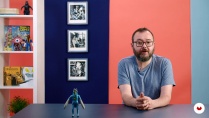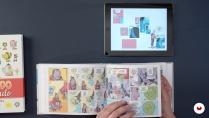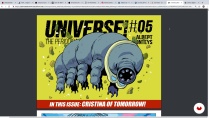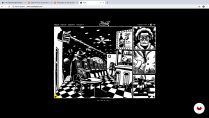Introduction to Digital Comic
A course by Albert Monteys Homar , Illustrator and Comic Book Writer
Joined September 2018

Learn to create, publish, and promote a graphic novel for digital formats
For cartoonist Albert Monteys, comics are his natural means of expression. After more than 25 years writing and drawing comics with ink, paper, screens, and a touch of humor, he's an expert in how to approach a comic from scratch and tell a story to be enhanced with digital media.
Known mainly for his comics in the Spanish humor weekly El Jueves, a publication in which he collaborated for 18 years and directed for four, he continued his career following his passion for narrative and the search for new digital formats, making comics for the humor magazine Pride and Satisfaction and the science fiction comic UNIVERSE!. This led him to receive a nomination for the 2016 Eisner award—the "Oscar for illustrators"—and to win the 2019 award for Best National Comic at the Salón del Cómic de Barcelona, Spain.
In this online course, cartoonist Albert Monteys teaches you how to create comics with a focus on digital formats, from the computer screen to the mobile screen. He also gives you the tools to promote your work, based on his experience, so you can share it with the world.
What will you learn in this online course?
26 lessons & 16 downloads
- 100% positive reviews (288)
- 5,978 students
- 26 lessons (3h 55m)
- 16 additional resources (6 files)
- Online and at your own pace
- Available on the app
- Audio: Spanish, English, French, Italian, Portuguese, Turkish
- Spanish · English · Portuguese · German · French · Italian · Polish · Dutch · Turkish
- Level: Beginner
- Unlimited access forever
What is this course's project?
Based on your story, create, publish, and promote a short comic online—between one strip and four pages—and get your work out into the world.
Projects by course students
Who is this online course for?
Illustrators, comic enthusiasts, with or without experience, and anyone who wants to explore graphic narrative and discover all the possibilities offered by different digital media.
Requirements and materials
It is essential to have a story to tell, and it's recommended that you have basic knowledge of drawing and use of Adobe Photoshop.
Regarding materials, you need a computer with the software installed, a pencil, markers, India ink, a paintbrush, a ruler, notebooks, drawing paper, and a scanner.

Reviews

Albert Monteys Homar
A course by Albert Monteys Homar
Albert Monteys is a Spanish cartoonist with more than 25 years of experience illustrating and writing comics. While starting out, he self-published his comics, which led him to collaborate for 18 years on the Spanish humor weekly El Jueves, a publication that he also directed for four years.
His passion for narratives led him to venture into the digital world, collaborating on the humor magazine Pride and Satisfaction and the science fiction comic UNIVERSO!
He has been nominated for the Eisner award at the 2016 Comic-Con, USA and won the award for Best National Comic at the Salón del Cómic de Barcelona, Spain in 2019.
Content
-
U1
Introduction
-
Presentation
-
Influences
-
What will we do during the course
-
-
U2
Thinking about the digital medium, the idea for our comic
-
What is the digital comic?
-
A world of formats
-
Color on screen
-
Infinite possibilities
-
-
U3
Analog and digital tools
-
Analog materials
-
Digital materials
-
Photoshop for comic cartoonists 1
-
Photoshop for comic cartoonists 2
-
-
U4
What story to tell and how to do it
-
The medium and the message, what format do I choose?
-
Writing the story, what do we tell
-
Character design
-
Planning the story, how do we tell it?
-
-
U5
Draw the comic
-
Acting for comics
-
Drawing at the service of reading 1
-
Drawing at the service of reading 2
-
Drawing at the service of reading 3
-
Digitizing the comic
-
Retouching and color 1
-
Retouching and color 2
-
Lettering, they are not just letters
-
-
U6
Presenting your comic to the world
-
Leave your comic ready for the screen
-
Promotion
-
Living off the story
-
-
FP
Final project
-
Introduction to the comic in digital support, from creation to publication
-
What to expect from a Domestika course
-
Learn at your own pace
Enjoy learning from home without a set schedule and with an easy-to-follow method. You set your own pace.
-
Learn from the best professionals
Learn valuable methods and techniques explained by top experts in the creative sector.
-
Meet expert teachers
Each expert teaches what they do best, with clear guidelines, true passion, and professional insight in every lesson.
-
Certificates
PlusIf you're a Plus member, get a custom certificate signed by your teacher for every course. Share it on your portfolio, social media, or wherever you like.
-
Get front-row seats
Videos of the highest quality, so you don't miss a single detail. With unlimited access, you can watch them as many times as you need to perfect your technique.
-
Share knowledge and ideas
Ask questions, request feedback, or offer solutions. Share your learning experience with other students in the community who are as passionate about creativity as you are.
-
Connect with a global creative community
The community is home to millions of people from around the world who are curious and passionate about exploring and expressing their creativity.
-
Watch professionally produced courses
Domestika curates its teacher roster and produces every course in-house to ensure a high-quality online learning experience.
FAQs
What are Domestika's online courses?
Domestika courses are online classes that allow you to learn new skills and create incredible projects. All our courses include the opportunity to share your work with other students and/or teachers, creating an active learning community. We offer different formats:
Original Courses: Complete classes that combine videos, texts, and educational materials to complete a specific project from start to finish.
Basics Courses: Specialized training where you master specific software tools step by step.
Specialization Courses: Learning paths with various expert teachers on the same topic, perfect for becoming a specialist by learning from different approaches.
Guided Courses: Practical experiences ideal for directly acquiring specific skills.
Intensive Courses (Deep Dives): New creative processes based on artificial intelligence tools in an accessible format for in-depth and dynamic understanding.
When do the courses start and when do they finish?
All courses are 100% online, so once they're published, courses start and finish whenever you want. You set the pace of the class. You can go back to review what interests you most and skip what you already know, ask questions, answer questions, share your projects, and more.
What do Domestika's courses include?
The courses are divided into different units. Each one includes lessons, informational text, tasks, and practice exercises to help you carry out your project step by step, with additional complementary resources and downloads. You'll also have access to an exclusive forum where you can interact with the teacher and with other students, as well as share your work and your course project, creating a community around the course.
Have you been given a course?
You can redeem the course you received by accessing the redeeming page and entering your gift code.











EXCELENTE CURSO, EL PROFESOR HA EXPLICADO MUY BIEN CADA MODULO, EN LENGUAJE SENCILLO Y DIRECTO.
Excelente introdução ao desenho de quadrinhos! Meu trabalho será o pontapé inicial para a minha carreira de ilustrado
¡Excelente curso!
¡Fantástico! Muy claro y sin bajar de nivel del resultado final.
¡Excelente curso!